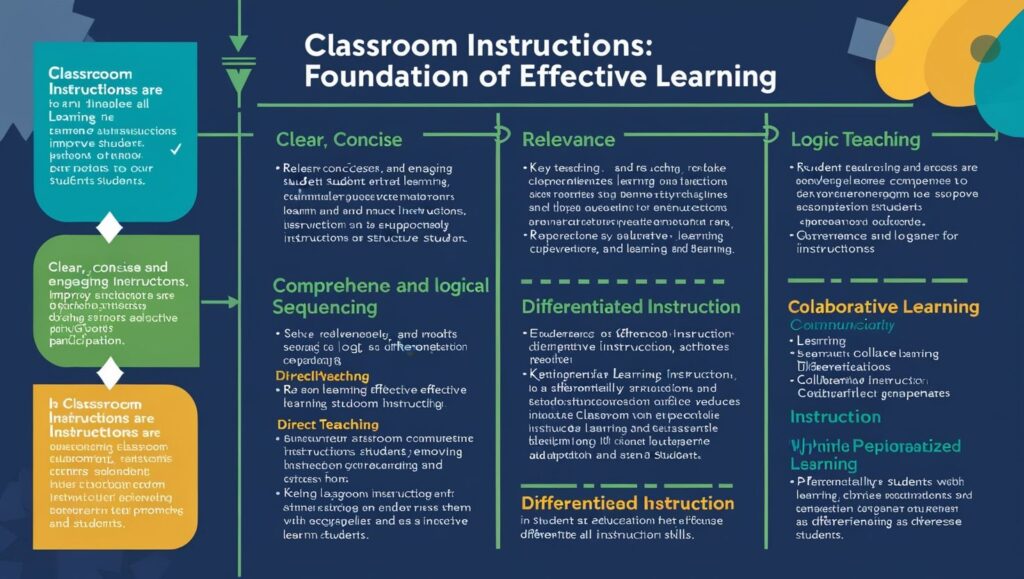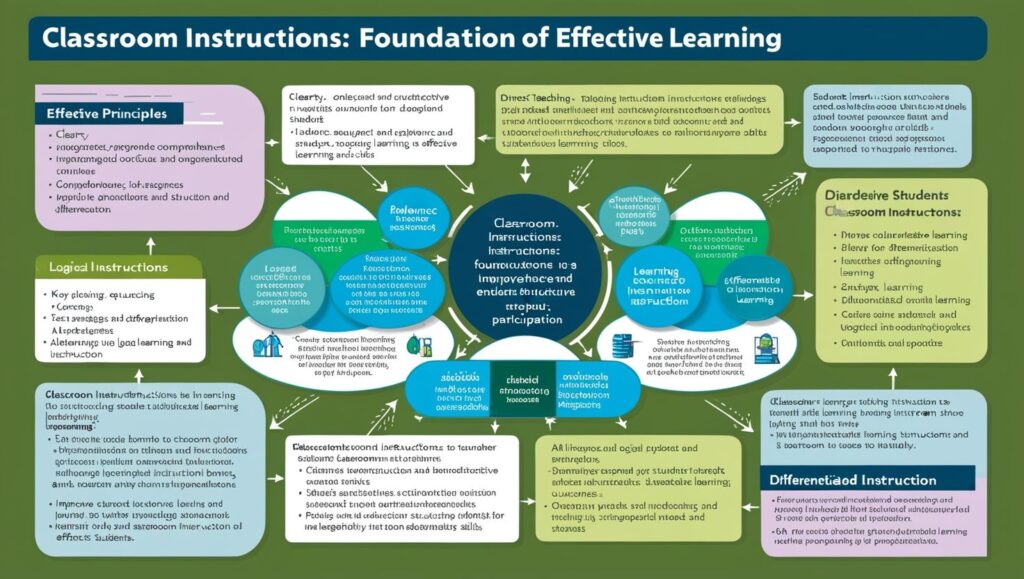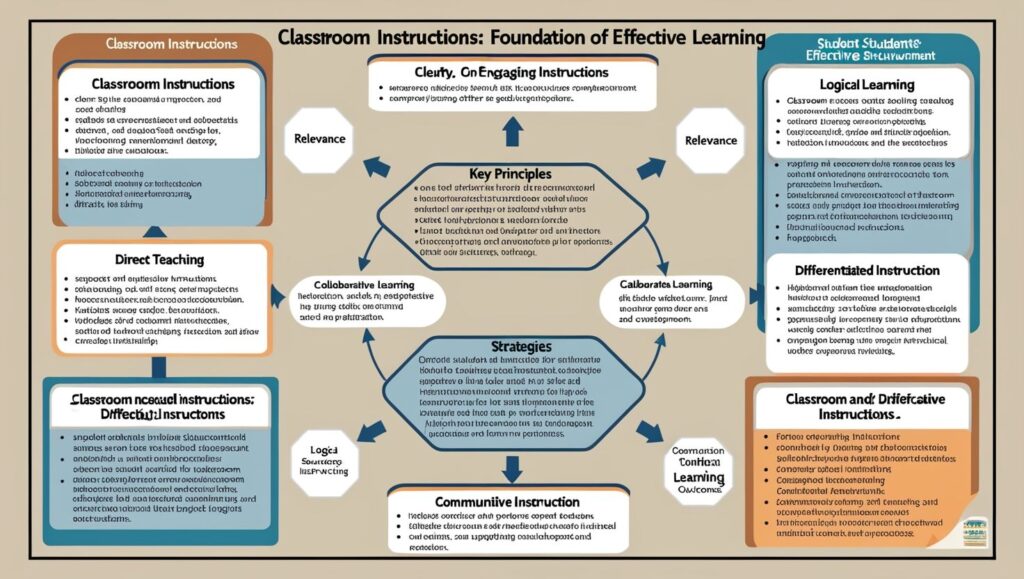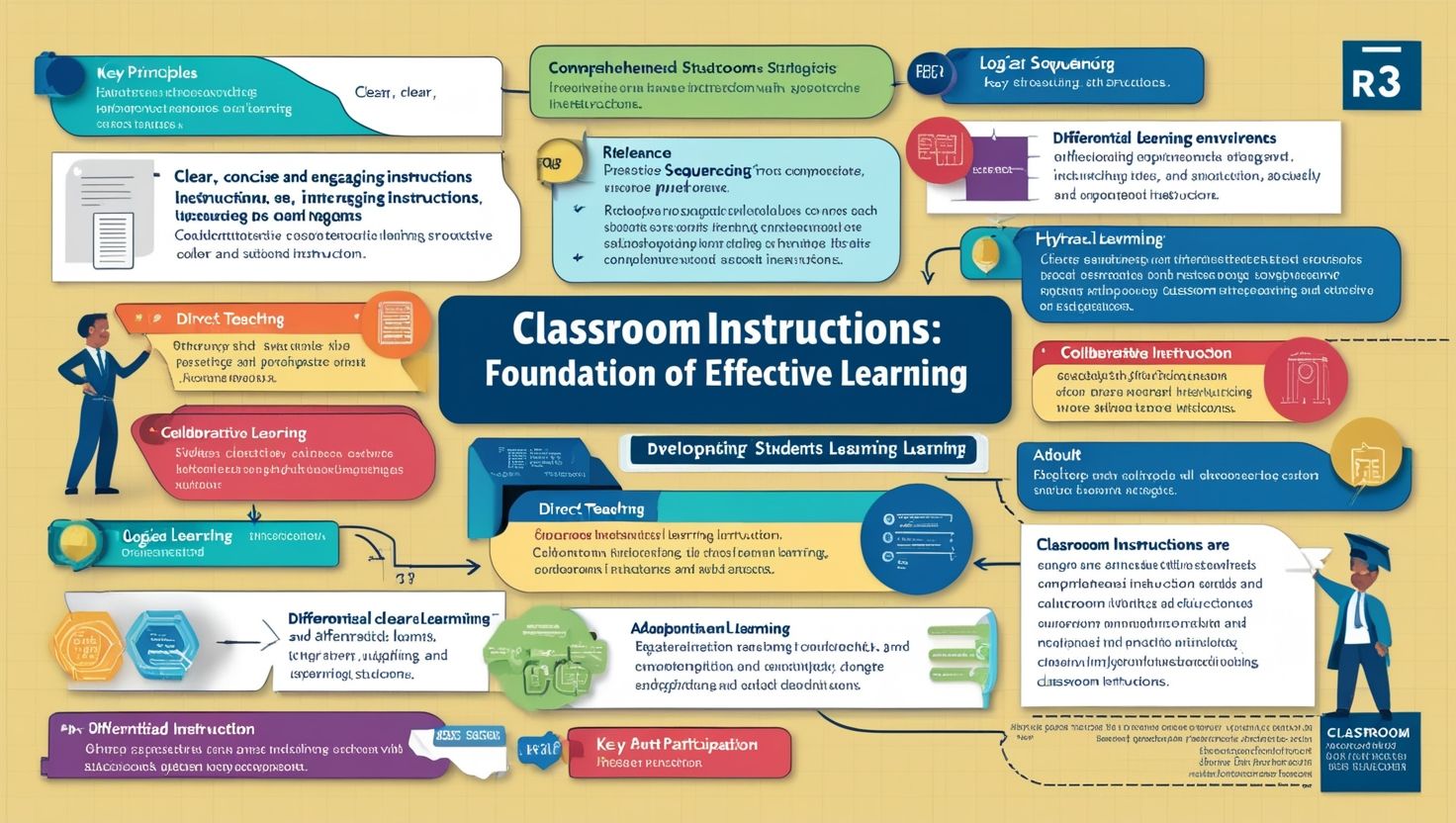Introduction
- Classroom Instructions lies at the heart of the educational experience, providing students with a structured environment where knowledge, skills, and critical thinking are fostered. Effective classroom instruction integrates a blend of teaching strategies, learning theories, and instructional tools to engage students actively and optimize learning outcomes. This article explores the importance of classroom instructions, key principles, effective instructional strategies, and the challenges faced, along with their solutions.
1. Importance of Effective Classroom Instructions
Effective classroom instructions are essential for several reasons:
- Enhanced Learning Outcomes: Clear instructions create an environment conducive to learning, helping students understand expectations and focus on tasks that reinforce core concepts.
- Promotes Student Engagement: Good instructions reduce confusion, encourage participation, and facilitate a sense of involvement among students, leading to active learning.
- Reduces Classroom Management Issues: Clear directions mitigate behavioral problems by giving students a clear purpose, which helps in maintaining classroom discipline.
- Supports Diverse Learners: Well-structured instructions benefit students with different learning needs, allowing teachers to accommodate various learning styles, such as visual, auditory, and kinesthetic.
2. Principles of Effective Classroom Instructions
Creating effective classroom instructions involves adhering to some key principles that make them clear, relevant, and accessible to all students.
2.1 Clarity and Specificity
Clarity in instructions is fundamental to student understanding. Instructions should be specific, direct, and avoid ambiguity to ensure students know exactly what is expected. Using straightforward language, repetition, and reinforcement methods can greatly enhance comprehension.
2.2 Relevance and Purpose
Instructions should relate directly to the learning objectives, so students understand why each task or activity is important. By connecting instructions to real-world contexts or previous knowledge, teachers can foster greater interest and engagement.
2.3 Sequential and Logical Order
Effective instructions are delivered in a step-by-step format that allows students to follow the process without confusion. This logical sequencing helps students to build upon each step, creating a structured path to completing tasks successfully.
2.4 Visual and Verbal Support
Using both visual aids (like diagrams or videos) and verbal explanations supports different types of learners. For instance, visual learners benefit from written or diagrammatic instructions, while auditory learners respond better to verbal guidance.
2.5 Scaffolding
Scaffolding breaks down complex instructions into manageable steps, which helps students build understanding incrementally. This technique allows teachers to gradually remove support as students gain confidence and competence.

3. Effective Instructional Strategies in the Classroom
Incorporating varied instructional strategies keeps students engaged and addresses the needs of different learners.
3.1 Direct Instruction
Direct instruction is a teacher-centered approach where information is presented clearly and concisely, often through lectures or demonstrations. This strategy works well for introducing new concepts but should be balanced with interactive methods to maintain engagement.
3.2 Inquiry-Based Learning
This method encourages students to ask questions and explore answers through research and experimentation. It fosters critical thinking and independent learning, allowing students to take an active role in their education.
3.3 Cooperative Learning
Collaborative activities, such as group projects or peer discussions, enable students to learn from each other. This strategy promotes social skills, teamwork, and a deeper understanding of concepts through shared knowledge.
3.4 Differentiated Instruction
Differentiated instruction tailors teaching to meet the varied learning needs of students. Teachers might provide different resources, adjust tasks, or offer personalized feedback to ensure that each student can engage with the material at their own pace.
3.5 Use of Technology
Integrating technology, such as digital tools or online resources, enhances engagement and offers interactive learning opportunities. For instance, tools like interactive whiteboards, virtual simulations, and learning management systems facilitate blended learning and can make complex concepts more accessible.
4. Role of Classroom Instructions in Fostering Critical Skills
Effective instructions do more than convey content; they also help students develop essential life skills.
4.1 Enhancing Communication Skills
When students follow and participate in guided activities, they practice expressing ideas, asking questions, and listening to peers, which enhances their communication skills.
4.2 Building Problem-Solving Abilities
Through clear instructions that outline steps to resolve issues or tackle tasks, students learn to approach problems systematically, enhancing their critical thinking and problem-solving abilities.
4.3 Encouraging Self-Discipline
Structured instructions provide students with a framework to follow, encouraging self-discipline and responsibility as they work to complete tasks independently.
4.4 Promoting Adaptability
By exposing students to various instructional styles and task structures, teachers prepare them to adapt to different challenges, an essential skill for lifelong learning.

5. Common Challenges in Classroom Instructions and Their Solutions
Teachers often encounter obstacles that hinder the effectiveness of classroom instructions, but these can be addressed with thoughtful strategies.
5.1 Language Barriers
Students who are non-native speakers or have limited language skills may struggle to understand instructions. Using simpler language, visual aids, or multilingual resources can bridge this gap.
5.2 Attention and Engagement Issues
Maintaining student focus is challenging in a world filled with distractions. Teachers can overcome this by using interactive elements, varying instructional methods, and incorporating frequent check-ins.
5.3 Differentiating for Diverse Learners
Addressing the varied learning needs within a single classroom is challenging. Teachers can use differentiated instructions and technology-based adaptive learning tools to offer personalized support to each student.
5.4 Time Constraints
The need to cover a set curriculum often restricts the time available for in-depth explanations or repeated instructions. Teachers can overcome this by prioritizing essential instructions, using efficient classroom management strategies, and assigning supplementary resources.
6. Measuring the Effectiveness of Classroom Instructions
Assessing the impact of instructional methods is essential for continuous improvement.
6.1 Student Feedback
Collecting feedback from students through surveys or informal discussions provides insights into the clarity and usefulness of instructions. Adjustments can be made based on their responses to improve future instruction.
6.2 Academic Performance
Assessing students’ work and understanding before and after instructions can highlight whether the instructions were effective in facilitating learning.
6.3 Classroom Observations
Self-assessment or peer observations can provide valuable perspectives on instructional delivery, identifying strengths and areas for improvement.
6.4 Reflective Teaching
Teachers can reflect on their instructional methods, assess student outcomes, and consider alternative strategies or adjustments. This continuous reflection is key to improving instructional effectiveness.

7. The Future of Classroom Instructions: Trends and Innovations
As education continues to evolve, innovative approaches to classroom instructions are emerging, reflecting technological advancements and changing pedagogical priorities.
7.1 Personalized Learning
The trend toward personalized learning tailors instructions to individual student needs. Adaptive learning technologies enable teachers to offer customized instructions based on each student’s progress and preferences.
7.2 Hybrid and Blended Learning
Hybrid models combine in-class and online instructions, allowing for flexible learning experiences. This method facilitates self-paced learning while still providing the structure of classroom interaction.
7.3 Use of Artificial Intelligence
AI-powered tools can assist in designing personalized instructional content and provide real-time feedback. This technology has the potential to revolutionize classroom instructions by offering detailed insights into student progress.
7.4 Project-Based Learning (PBL)
PBL is gaining traction as an alternative to traditional classroom instructions. It engages students in real-world projects, fostering critical thinking, collaboration, and problem-solving skills.
Conclusion
Effective classroom instruction is crucial for enhancing student learning and engagement. By adhering to principles of clarity, relevance, and scaffolded support, teachers can create an environment where students are motivated to learn and equipped to meet educational challenges. The role of classroom instructions goes beyond academic achievement; it fosters life skills such as communication, critical thinking, and adaptability. As educational technology and pedagogical approaches evolve, teachers have more tools at their disposal to provide engaging, personalized, and impactful instructions. Continuous adaptation and assessment of instructional methods will ensure that classroom instruction remains effective and relevant in the dynamic educational landscape.
References
- Fisher, D., & Frey, N. (2014). Better Learning Through Structured Teaching: A Framework for the Gradual Release of Responsibility. ASCD.
- Marzano, R. J., & Pickering, D. J. (2011). The Highly Engaged Classroom. Marzano Research Laboratory.
- Tomlinson, C. A., & Imbeau, M. B. (2010). Leading and Managing a Differentiated Classroom. ASCD.
- Mayer, R. E. (2009). Multimedia Learning. Cambridge University Press.
- Hattie, J. (2009). Visible Learning: A Synthesis of Over 800 Meta-Analyses Relating to Achievement. Routledge.
- Gagné, R. M. (1985). The Conditions of Learning and Theory of Instruction. Holt, Rinehart and Winston.

8 thoughts on “Classroom Instructions”
Comments are closed.